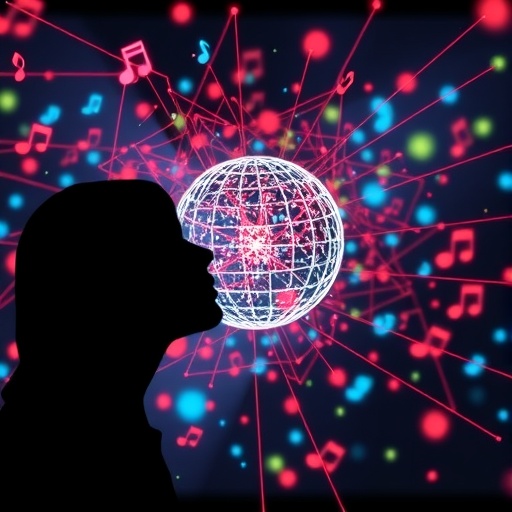In an era where artificial intelligence is rapidly transforming creative domains, an innovative study has emerged, focusing on the intersection of AI and emotional music generation. This ongoing research, conducted by Li, L., presents a comprehensive exploration of how machine learning algorithms can not only generate music but also evaluate the emotional resonance of compositions. The findings are groundbreaking, providing insight into a field that blends technology with the intricate tapestry of human emotion.
At the core of this study is the recognition that music has a profound impact on human emotions. Throughout history, composers have strived to evoke feelings through melodies, harmonies, and rhythms. However, the potential for AI to replicate and even enhance this emotional experience opens up exciting avenues for both music creation and therapeutic applications. Li’s work underscores how AI can analyze vast datasets of musical compositions, learning to understand the nuances that elicit emotional responses from listeners.
One of the primary methodologies employed in this research involves the use of deep learning. By training neural networks on diverse musical genres and styles, the algorithms are able to uncover patterns that characterize emotionally evocative music. This approach enables the generation of new pieces that not only adhere to established musical norms but are also capable of stirring the listener’s emotions. The ability to synthesize music that resonates on an emotional level could revolutionize the way we interact with sound and art.
Moreover, the study introduces a multidimensional evaluation framework for assessing the emotional impact of generated music. Traditional music analysis often relies on superficial metrics, such as tempo and volume, but Li advocates for a more nuanced approach that considers the psychological and sociocultural context of musical experiences. This framework incorporates feedback from human listeners, allowing the AI system to refine its output based on real emotional responses rather than predetermined criteria.
The implications of such technology extend far beyond mere entertainment. Emotional music generation has significant potential in therapeutic settings. For individuals dealing with mental health issues, customized music that aligns with their emotional state can be a powerful tool for healing. By generating tracks that resonate with specific feelings, AI could facilitate emotional processing and recovery in innovative ways. This is particularly relevant in the context of music therapy, where tailored soundscapes can aid in relaxation, reflection, and emotional expression.
Further complicating the relationship between AI-generated music and human emotions is the concept of authenticity. As machines create music that is indistinguishable from human compositions, questions arise regarding the essence of artistic expression. Can an algorithm truly understand or replicate the depth of human emotion, or does it merely mimic patterns it has been trained on? Li’s research invites discourse on the philosophical implications of AI in creative fields, challenging perceptions of what it means to be an artist in the digital age.
In addition to therapeutic applications, commercial prospects for AI-generated music are also vast. The demand for fresh, original soundtracks in film, video games, and advertising continues to grow. AI systems capable of producing music that resonates with audiences can provide cost-effective solutions for content creators seeking to enhance their projects without investing significant time and resources in traditional composition processes. This potential for scalability presents new economic models for the music industry, which has been in flux as streaming services dominate.
Moreover, as the technology develops, the concept of collaborative music creation between humans and AI begins to emerge. Musicians can partner with AI tools to push creative boundaries, augmenting their compositions with sophisticated algorithms that offer suggestions or even complete sections. This collaborative framework could redefine the creative process, allowing for a more dynamic interplay between human artistry and computational power.
However, the path forward for AI in music generation is not without challenges. The ethics of authorship and copyright are pressing issues that must be addressed as AI-created works become increasingly prevalent. If a machine composes a piece of music, who holds the rights to that work? Furthermore, the potential for homogenization of musical styles is a concern as AI tends to draw on existing data, which could stifle innovation and reduce the diversity of musical expression available to audiences.
In conclusion, Li’s study on emotional music generation through artificial intelligence opens a Pandora’s box of possibilities for the future of music and emotional engagement. The intersection of technology and art could lead to unprecedented advancements in how we create, experience, and understand music on an emotional level. As AI continues to evolve, the potential for new genres, therapeutic methods, and collaborative processes highlights both the promise and complexity of integrating machine intelligence into a traditionally human domain.
As the research progresses, one can only anticipate the innovative developments that will arise in the field of AI and music. The allure of a future where machines and humans co-create art that resonates deeply within us may soon become a reality, forever changing the landscape of music and emotional connection.
Subject of Research: Emotional music generation and its evaluation through artificial intelligence.
Article Title: Emotional music generation and multidimensional evaluation based on artificial intelligence.
Article References:
Li, L. Emotional music generation and multidimensional evaluation based on artificial intelligence.
Discov Artif Intell (2025). https://doi.org/10.1007/s44163-025-00672-4
Image Credits: AI Generated
DOI: 10.1007/s44163-025-00672-4
Keywords: AI, music generation, emotional impact, deep learning, music therapy, creative collaboration, copyright, ethical considerations.
Tags: AI in creative industriesAI music generation techniquesdeep learning in music compositionemotional impact of melodiesemotional resonance in musichuman emotion and musicinnovative music evaluation methodsintersection of technology and artmachine learning for emotional analysismusic datasets for AI trainingneural networks in music creationtherapeutic applications of AI music





